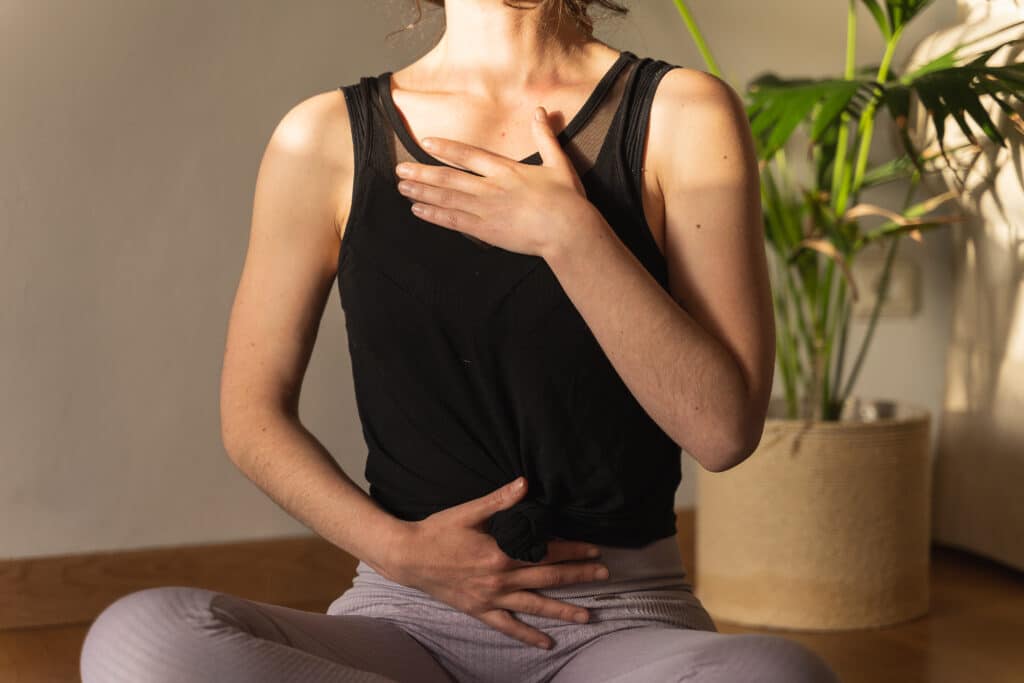When people consider a ‘high’, they usually think of recreational substances, such as: MDMA, cannabis, cocaine or LSD. But what about the high you get from yoga? This ancient practice, originating in India, has been embraced worldwide for its numerous physical, mental, and spiritual benefits. Many practitioners report experiencing a heightened sense of well-being and tranquility after a yoga session, often referred to as the ‘yoga high’.
While it might not be the exact same as being high on drugs, the term signifies a state of heightened awareness, deep relaxation, and euphoria that can be attained through practice. In this article, we’re going to be exploring the reasons behind this high and how this ancient discipline can lead individuals to experience blissful, elevated states of consciousness.
What is a ‘High’?
The word ‘high’ encompasses many feelings. This sensation can be triggered by recreational substances mostly, but it doesn’t end there. This feeling generally refers to an altered state of consciousness or sensation that is different from one’s usual state of mind and body. It might be often associated with the use of substances like drugs or alcohol, but it can also be experienced naturally through activities like meditation, extreme physical exertion, or intense emotional experiences. Whilst high feelings can seriously differ, there does seem to be a common thread amongst them. Here is a range of sensations and effects that an individual might feel during their high:
- Euphoria: A feeling of intense happiness, pleasure, and well-being. This is usually linked to an increase of dopamine or serotonin.
- Altered perception: Changes in sensory experiences, such as enhanced colours, intensified sounds, or distorted visuals.
- Increased energy: A surge in energy, alertness, and activity.
- Relaxation: A sense of calmness and reduced anxiety.
- Decreased inhibitions: A lowered sense of caution and increased willingness to take risks or engage in behaviours one might not consider when sober.
- Distorted thinking: Changes in thought patterns, which can lead to unconventional or creative thinking.
- Time distortion: A perception that time is passing differently, either slower or faster than usual.
- Heightened sensory experiences: Sensitivity to touch, taste, smell, sight, and sound.
As we can see, these sensations can definitely spread themselves over a variety of substances or activities. In other words, you can get high from spiritual things, just as much as you can from recreational substances. So what about yoga?
Yoga
Yoga has a vast history, spanning thousands of years and evolving across different cultures and regions. Its origins can be traced back to ancient India, where it emerged as a multifaceted practice that encompasses physical, mental, and spiritual dimensions. Whilst many Western nations now use yoga as a fitness exercising tool, it’s important to remember what it was created for. Spiritualism is often overlooked in Europe and America, whereas if you go to India you’ll be able to witness the whole point of yoga. Ayush Yoga writes:
“Thus the aim of Yoga is Self-realization, to overcome all kinds of sufferings leading to ‘the state of liberation’ (Moksha) or ‘freedom’ (Kaivalya). Living with freedom in all walks of life, health and harmony shall be the main objectives of Yoga practice.”
For many Hindus and Buddhists, yoga goes hand in hand with meditation. The idea is to have control over your own destiny and, in essence, mind. By understanding your brain, thoughts and body – you come a step closer to peace. The yogic practices have been around for centuries and are far more deep and spiritual than any teacher – who’s headed off to Bali for a month – will truly understand. This depth could be the cause of the ‘high’ phenomenon.
The Science
The practice of yoga has a profound impact on the brain, influencing various neurological processes and leading to an altered state of consciousness. Regular yoga practice can stimulate the parasympathetic nervous system, triggering the relaxation response and reducing stress hormone levels. This shift in the body’s neurochemistry fosters a sense of calmness and well-being, akin to the feeling of being high.
Furthermore, studies have shown that yoga promotes the release of neurotransmitters like serotonin, dopamine, and endorphins, which are commonly associated with positive emotions and feelings of happiness. The combination of physical postures (asanas), controlled breathing (pranayama), and meditation in yoga creates a unique sensation that can elevate mood and provide a sense of euphoria.
Flow State
But there’s more to yoga than simple euphoria. Anyone who does exercise regularly will tell you that they often come home feeling a lot happier than they did before. But yoga, in particular, has something else about it too. The concept of ‘flow state”, coined by psychologist Mihaly Csikszentmihalyi, refers to a state of heightened focus and complete immersion in an activity. In flow, time passes at a different rate, and sometimes even awareness is increased. Yoga is a prime avenue for experiencing this flow state. Using breath and repetitive moves – which also stretch all parts of the body – you can reach another plane of consciousness.

Pranayama, the art of conscious breathing in yoga, can lead to profound changes in the body’s energy or life force, known as prana. Controlled and focused breathing practices can increase the flow of prana throughout the body, invigorating the mind and spirit. The deep and rhythmic breathing techniques employed in yoga stimulate the vagus nerve, which helps regulate the autonomic nervous system. Now, tell me, is this or this not akin to a high feeling? This might sound a little pretentious, but that’s probably because more genuine research is going into the science of yoga, and it seems there really is a science around it. This practice has been getting people ‘high’ for centuries, but not in a destructive way.
Awakening of the Endocannabinoid System
It’s also important to mention that there is some very interesting research into yoga and its relationship with the endocannabinoid system (ECS). This is a complex network of receptors and neurotransmitters in the body that plays a crucial role in maintaining homeostasis and overall well-being. The ECS is also responsible for the psychoactive effects of cannabis when interacting with its compounds, such as THC. What does this have to do with yoga? Well, surprisingly, yoga practice has been found to influence the endocannabinoid system, promoting the production and release of endocannabinoids like anandamide, often referred to as the ‘bliss molecule’. This might have a milder effect than THC, but it still contributes to feelings of joy, relaxation, and a sense of being high.
Meditation
You cannot mention yoga without also mentioning meditation. Meditation, a central component of yoga, plays a pivotal role in inducing altered states of consciousness. Altered states of consciousness, remember, was another major sensation of feeling high. The western world usually splits meditation and yoga in two, offering classes in both. If you do a yoga course in India, you’ll see that they very much believe the two are deeply intertwined. RO writes:
“Meditation or “dhyana” is also a part of yoga. Like the physical practice of yoga, dhyana also forms a profound connection with the universe by doing mental exercises to bring you to a higher state of consciousness. This connection happens in savasana when you are in a meditative, peaceful state (Mohammad, 2019)”
This higher state of consciousness is very similar to that of ego-death, which is usually caused by psychedelic drugs like LSD, psilocybin or even ketamine. Through various meditation techniques, such as mindfulness and concentration practices, individuals can enter deeper states of relaxation and introspection, leading to heightened sensory experiences. Meditation also triggers the release of different neurochemicals in the brain, such as gamma-aminobutyric acid (GABA), which reduces anxiety, and melatonin, which regulates sleep and enhances relaxation. The cumulative effect of these changes results in a sense of euphoria and inner peace, akin to the experience of being high.
Conclusion
So, can yoga get you high? The short answer is: absolutely yes. But perhaps there’s a longer answer too. The truth is, yoga releases a lot of the same chemicals and causes a lot of the same feelings as recreational drugs do (but perhaps not as potently). Many yogis have spoken about how reaching these sustained alternative realities and heightened consciousnesses can take decades. Whilst you can feel high after a yoga class, that real sustained high may take a life to learn. Perhaps this is why many turn to recreational substances as a quick fix, an instance chance to feel what those spiritual individuals feel. Nonetheless, the yoga high is real and you can certainly strive to experience it too.
Hello readers. We’re happy to have you with us at Cannadelics.com; a news source here to bring you the best in independent reporting for the growing cannabis and hallucinogen fields. Join us frequently to stay on top of everything, and subscribe to our Cannadelics Weekly Newsletter, for updates straight to your email. Check out some awesome promos for cannabis buds, smoking devices and equipment like vapes, edibles, cannabinoid compounds, amanita mushroom products, and a whole bunch more. Let’s all get stoned together!





